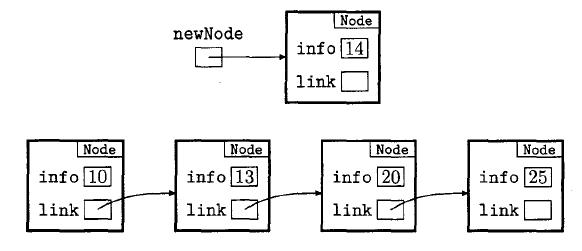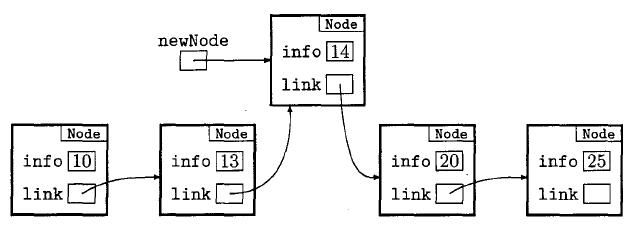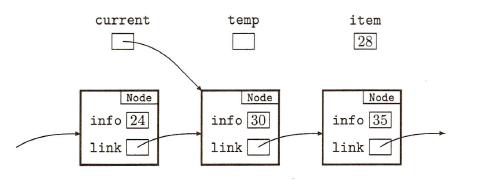12.2 More Operations on Linked Lists
Although the list manipulation techniques discussed in the previous section
are adequate for some applications, many problems require more advanced
techniques, using one or more auxiliary reference variables to keep track of
nodes while links are being adjusted.
As a first example, let us consider the problem of inserting a new node
into a list where the nodes of the list are to be ordered. For the simple
list structure that we are using, let us suppose that we want to maintain
our lists in ascending order by the info fields of the nodes. To illustrate
the problem, consider the portion of the list shown in the next diagram
and suppose that we want to insert a node containing the value 14 into its
correct position.

The insertion process consists, essentially, of simply changing the appropriate
link fields to achieve the structure shown in the next diagram.

The insertion is carried out in two phases: first the correct location
for the new node is found and then links are adjusted so that the node
is inserted in the list at this point. To find the correct location for the
value 14, we traverse the list using an auxiliary reference variable until we
reach the node containing the next largest value, 20. The new node should
be inserted just before this one. At this point, it is easy to link the new
node to the node containing 20 but we cannot go back along the list to
link the previous node, containing 13, to the new node because the links
only point forward, not backward. One solution to this problem is to use
two auxiliary reference variables in our traversal: one to the current node
being examined and the other to the previous node. With these variables
we can, if necessary, link the previous node to the new one. This process
is implemented in the next example.
Example 1The method insert will insert a node containing the value item in its info
field in a linked list in which the info fields of the nodes are in ascending
order.
public void insert (int item)
{
// Find correct location in list for new item
Node current = head;
Node previous = null;
boolean located = false;
while (!located && current != null)
if (item < current.info)
located = true;
else
{
previous = current;
current = current.link;
}
// Create a new node containing item and
// referring to correct location in list
Node newNode = new Node(item,current);
// set link to refer to new node
if (current == head)
head = newNode;
else
previous.link = newNode;
}
|
|
To delete a node containing a particular value in its info field, we
must first search the list to find the node that is to be deleted and then
adjust links so that this node is snipped out and the reference to the deleted
node is redirected to the following node (if there is one). Here again, we
must be careful to keep track of the node preceding the one currently being
examined so that we can adjust its link, if necessary.
Example 2This method searches an unordered linked list for a node containing the
value item in its info field. If it finds such a node, it deletes it from the
list. If there is no such node, the method does nothing; if there is more
than one node containing item, only the first is deleted.
public void delete (int item)
{
// Search for node to be deleted
Node current = head;
Node previous = null;
boolean found = false;
while (!found && current != null)
if (current.info == item)
found = true;
else
{
previous = current;
current = current.link;
}
// Perform deletion, if item found
if (found)
if (current == head)
head = head.link;
else
previous.link = current.link;
}
|
|
Exercise 12.2
- The diagram shows a portion of a linked list. In the diagram, both current
and temp are references to objects of the type Node that we have been
studying while item is of type int.

Draw a diagram, similar to the one given here, illustrating the result
of executing the following fragment.
temp = new Node(current.info,current.link);
current.info = item;
current.link = temp;
- Write an instance method called contains for the List class. The
method should have header
public boolean contains (int item)
The method should return true if and only if its implicit List object
contains item.
- In Chapter 10, we developed a fast searching method (binary search)
that took advantage of the fact that a sorted array can be searched
much more efficiently than an unsorted one. If the nodes of a linked
list are ordered, can we write a form of binary search for a linked list?
Justify your answer.
- Write an instance method deleteAll for the List class. The method
should have one int parameter, item. It should delete all nodes in
the list that contain item in their info fields.
- Complete the definition of the method whose header is
public boolean isOrderedIncreasing()
The method should return true if and only if the info fields of the
implicit List object are in strictly increasing order. Assume that the
info fields are references to objects for which a compareTo method
exists.
- The technique shown in Question 1 can be used to insert a value
into an ordered list without using two auxiliary references. Write an
instance method that uses this technique to achieve the same effect
as the method shown in Example 1. (Be sure that your method works
at both ends of the list.)
- Write an instance method isldentical for the List class. The
method should have the header
boolean isldentical (List other)
The method should return true if and only if its implicit List object
is identical to other.
|
|


